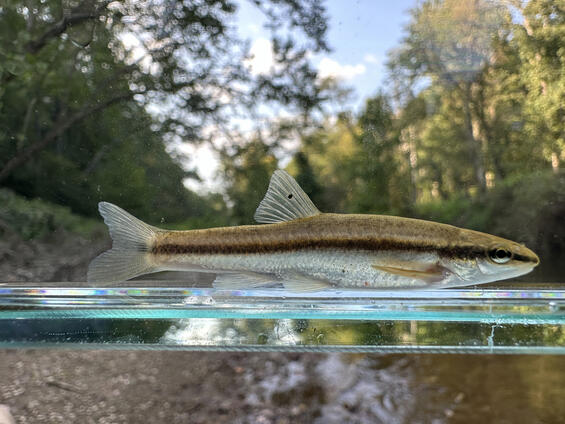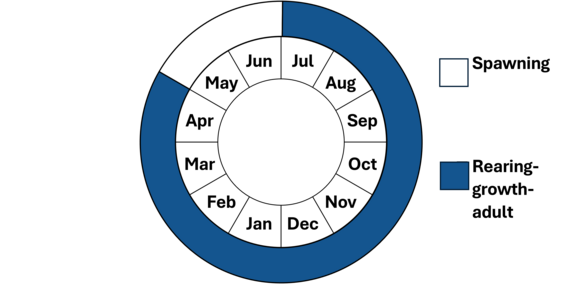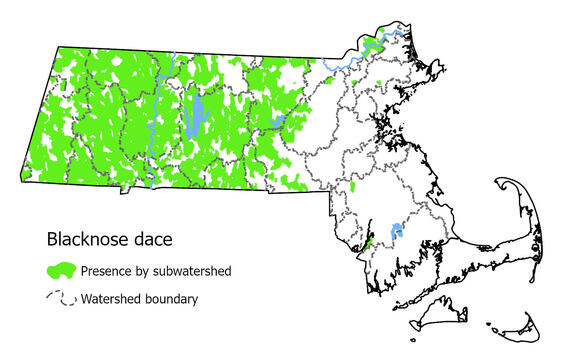- Scientific name: Rhinichthys atratulus
- Species of Greatest Conservation Need (MA State Wildlife Action Plan)
Description

Blacknose dace (Rhinichthys atratulus)
The blacknose dace has an elongated fusiform body shape with very small scales giving it a smooth feel. This species has a barbel at each corner of the small slightly inferior-positioned mouth, and a band of tissue (frenum) that connects the upper lip to the snout. A dark stripe running around the snout, through the eyes, and along the lateral line separates the olive-brown back from the silvery-white belly. In breeding males, overall pigment becomes darker, the pectoral, pelvic, and anal fins turn an orange hue, and prominent tubercles become present on the head and fins. blacknose dace can typically reach a length of approximately 7.5 cm (3 in) but may grow to a maximum length of 13 cm (5 in). They can live up to 3 or 4 years.
The blacknose dace is most similar to the longnose dace but can be distinguished by the relative length of the snout (shorter than the longnose dace), the eye size, the position of the eye in relation to the mouth, and the presence of a stripe on the snout.
Life cycle and behavior

Blacknose dace feed on a wide variety of small aquatic invertebrates, terrestrial insects, and algae. Aquatic fly larvae are a favored prey.
Blacknose dace spawn in late spring-early summer (~May-June). Female dace deposit their eggs into small depressions or clearings in the substrate of shallow gravel riffles, where they are fertilized by a single male. There is no parental care.
Distribution and abundance
The blacknose dace can be found in most small to medium sized streams in central and western Massachusetts and is the most common stream minnow, occurring from the Hudson to the Blackstone drainages and north through western portions of the Merrimack River Drainage. In the eastern portion of the state, blacknose dace are found in five tributaries to the Merrimack River, and in four streams in the Concord-Assabet River Drainage. The species likely had a much more statewide distribution and is now absent from all other Massachusetts coastal drainages.

Data from 1999-2024 from annual surveys.
Habitat
This species appears in most cool and coldwater streams and small rivers, especially those with good cover and rocky substrate.
Healthy habitats are vital for supporting native wildlife and plants. Explore habitats and learn about conservation and restoration in Massachusetts.
Threats
Water pollution, warming water temperatures, habitat fragmentation, and sediment deposition in spawning areas are possible threats to this species. Climate change is likely to impact this coolwater species as temperatures in rivers continue to warm and flood and drought extremes increase.
Conservation
Not enough is known about blacknose dace in Massachusetts waters to develop a species-specific management plan. They are part of a riverine fish community that will benefit from stream habitat restoration including water quality, water quantity, and physical habitat restoration. It is anticipated that conservation and management initiatives targeting keystone species, such as brook trout, or broader ecosystem-based management objectives would also be indirectly beneficial to blacknose dace.
References
Karsten E. Hartel, David B. Halliwell, and Alan E. Launer. Inland Fishes of Massachusetts. Lincoln, Massachusetts: Massachusetts Audubon Society, 2002
Contact
| Date published: | April 11, 2025 |
|---|